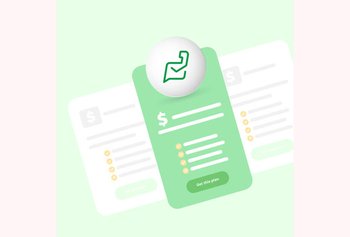Your Comprehensive Guide to Live Chat Support
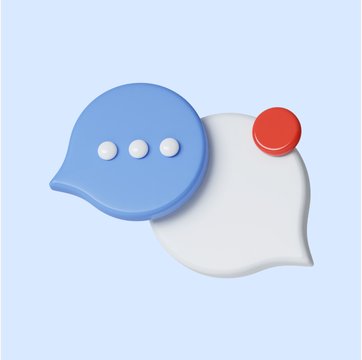
Table of contents
Customer support isn’t just about solving problems; it’s about elevating the entire customer experience. And in a world where instant gratification isn’t fast enough, live chat support offers real-time engagement that can significantly impact your business metrics—from customer satisfaction and retention to overall sales.
But let’s not just scratch the surface. This article is your go-to resource for mastering live chat support. We’re talking about choosing the right software tailored to your business needs, training your team to handle real-time queries effectively, and implementing best practices that convert visitors into loyal customers. Plus, we’ll dive into key performance indicators to ensure your live chat support isn’t just running but excelling.
So, if you’re committed to elevating your customer support game, you’re in the right place. This is your comprehensive guide to everything live chat support.
Table of Contents
- What do you mean by Live Chat Support?
- Example of Live Chat Support
- 6 Benefits of Live Chat Support (with examples)
- 5 KPIs (Key Performance Indicators) for Live Chat Support
- Types of Live Chat Support
- How to Choose the Right Live Chat Support Software
- Get Started
What do you mean by Live Chat Support?
Live chat support is a customer service method that allows businesses to engage with customers in real-time through a chat interface, typically located on a website or mobile application.
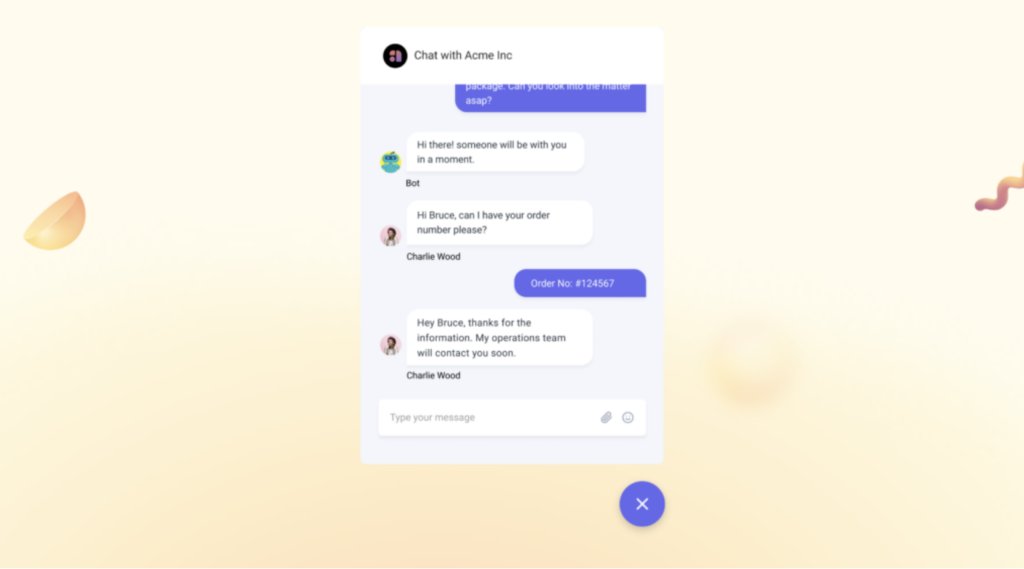
It aims to provide immediate assistance, answer queries, and resolve issues, thereby enhancing customer satisfaction and potentially increasing sales and customer retention rates.
Example of Live Chat Support
Imagine you’re the owner of an online store specializing in outdoor gear. You’ve recently added a new tent to your inventory, and you’re keen on making it a bestseller. You’ve set up live chat support to assist potential customers in real-time.
One afternoon, you notice a visitor browsing the tent section of your website. They seem interested but haven’t added anything to their cart yet. That’s when your live chat tool triggers a proactive chat invitation, displaying a chat icon at the bottom right corner of their screen.
The visitor clicks on the chat icon, and your live chat agent is alerted. The agent promptly greets the visitor with a message: “Hi there! How can I assist you today?”
The visitor types in a couple of questions about the tent’s waterproof capabilities and setup process. Your agent, well-trained and equipped with detailed product knowledge, responds within seconds. They provide information about the tent’s waterproof rating and offer a step-by-step guide on setting it up.
The visitor is impressed with the quick and thorough response. They add the tent to their cart and complete the purchase.
From a business standpoint, your live chat support just turned a browsing visitor into a paying customer. You not only answered their questions in real-time but also prevented a potential drop-off that could have occurred if the visitor had to wait for an email response. Your operational efficiencies improved, and you secured a sale that might have otherwise been lost.
6 Benefits of Live Chat Support (with examples)
If you’re still on the fence, let’s talk about why live chat is more than just a trendy add-on—it’s a game-changer for your business and your customers.
1. Quick Response Time
Nobody likes to wait, especially online. With live chat support, you can answer customer queries in real-time. No more waiting for emails to be answered or calls to be picked up.
Imagine a customer is stuck at the checkout page, unsure about shipping options. A quick chat can clarify things and seal the deal within minutes.
2. Convenience for Customers
People love multitasking. Live chat allows customers to get support while they continue to browse your site or even step away from their computer.
A customer can chat with support about a software issue while simultaneously working on a different project. No need to halt everything just to make a phone call.
3. Increases Sales and Customer Retention
When customers get immediate, helpful responses, they’re more likely to stay and make a purchase.
Let’s say someone’s browsing winter coats but can’t decide on the size. A live chat agent can offer real-time advice, increasing the chances of a satisfied customer and a successful sale.
4. Cost-Effective
Compared to phone support, live chat is often more cost-effective as agents can handle multiple chats simultaneously.
One agent can manage three to four chats at once, resolving issues more efficiently than juggling multiple phone calls.
5. Builds Trust
Having a live chat option shows customers you’re accessible, which can go a long way in building trust.
A first-time visitor to your site might be hesitant to make a purchase. Seeing that live chat support is available can provide the assurance that they can instantly get help to any questions they may have about the product and complete their transaction.
6. Data Collection
Live chat isn’t just for solving problems; it’s a goldmine for customer data. You can use this information to improve products, services, and even your website’s user experience.
If multiple customers are asking about a specific feature through live chat, that’s a cue for you to make that information more prominent on your site or to consider adding that feature if it’s missing.
It’s not just about solving issues; it’s about enhancing the entire customer journey, from first click to loyal customer.
5 KPIs (Key Performance Indicators) for Live Chat Support
So you’ve set up your live chat support, and it’s up and running. Great! But how do you know it’s actually working? That’s where KPIs come into play. These metrics help you gauge the effectiveness of your live chat support and identify areas for improvement. Let’s break down the most crucial ones.
1. Customer Satisfaction Score (CSAT)
CSAT is a straightforward metric that gauges customer satisfaction based on their recent interaction with your live chat support. It’s usually measured through a post-chat survey where customers rate their experience on a scale, often ranging from “Very Unsatisfied” to “Very Satisfied.”
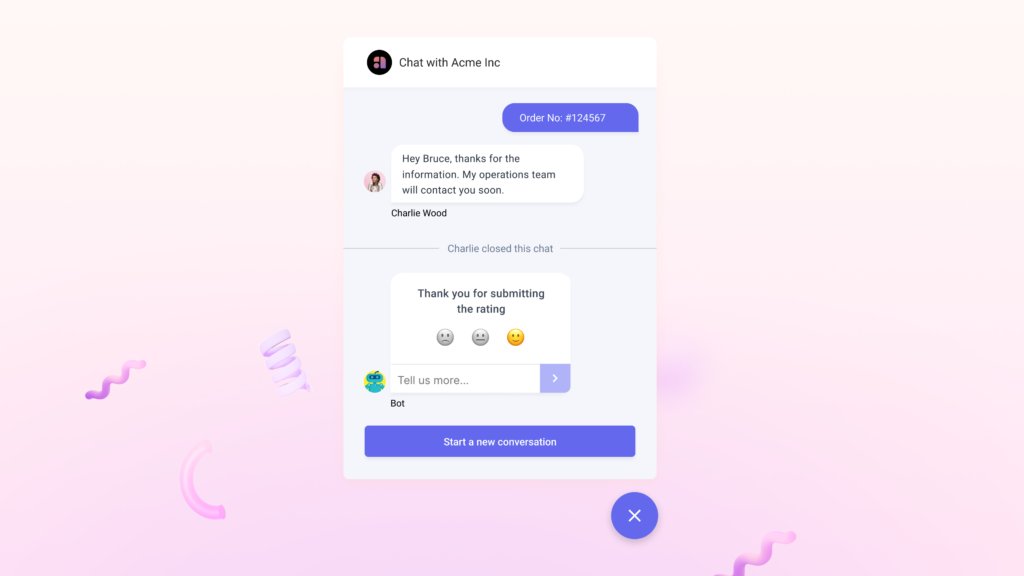
Measuring CSAT is typically done through a quick survey sent immediately after the chat session ends. The quicker you send it, the more accurate the feedback will be.
Keep the survey short and to the point to encourage participation. One or two questions are often enough to gauge customer satisfaction effectively.
Interpreting CSAT Scores
High CSAT, Fast Response Time: If you notice that high CSAT scores often coincide with fast response times, it’s a clear indicator that speed is a priority for your customers.
High CSAT, Long Resolution Time: On the flip side, if CSAT scores remain high even when resolution times are longer, it suggests that customers appreciate thorough, detailed support over quick fixes.
Low CSAT During Peak Hours: If you observe lower CSAT scores during peak business hours, it could mean you’re understaffed, leading to slower response times and decreased customer satisfaction.
Agent-Specific CSAT: If certain agents consistently receive higher or lower CSAT scores, this could indicate areas where training or process adjustments are needed.
2. Response Time
Response Time is the average time it takes for an agent to respond to a customer’s initial message. It’s the first touchpoint in the customer’s experience and sets the tone for the entire interaction.
Most live chat software comes with built-in analytics that track this metric. It’s usually measured in seconds or minutes.
Keep an eye on how response times vary during different times of the day or week. This can help you optimize staffing levels.
Interpreting Response Times
Consistently Fast Response Times: If your metrics show consistently fast response times but low CSAT scores, you may need to focus on improving the quality of your responses.
Response Time by Query Type: Some queries may naturally take longer to respond to. Segmenting response times by query type can help you identify if additional training or resources are needed for certain topics.
Response Time by Agent: If certain agents have notably faster or slower response times, this could indicate a need for additional training or a review of workload distribution.
Response Time During Promotions: If you notice slower response times during promotional periods, it might be a sign that you need to allocate more resources during these high-traffic times.
Response Time by Customer Segment: If you serve a diverse customer base, consider breaking down response times by customer segments. For instance, if response times are slower for international customers, you may need to consider time zone differences in your staffing.
3. Resolution Time
Resolution Time is the average time it takes to resolve a customer’s issue or query from the moment they initiate the chat to the moment the issue is resolved.
A shorter Resolution Time generally leads to higher customer satisfaction. It shows that you’re not just quick to respond, but also effective in solving problems.
It’s crucial to differentiate between the time spent actively resolving an issue and the total chat duration, which may include idle time.
Interpreting Resolution Times
High CSAT, Long Resolution Time: If you have high CSAT scores but longer Resolution Times, it could mean that customers appreciate the thoroughness and quality of your support.
Short Resolution Time, Low CSAT: Conversely, if Resolution Times are short but CSAT scores are low, you may be rushing through chats at the expense of quality.
Resolution Time by Issue Complexity: Different issues require different amounts of time to resolve. Segmenting Resolution Times by the complexity of the issue can provide insights into whether you need specialized agents for certain topics.
Resolution Time and Repeat Contacts: If customers frequently return for the same issue, it may indicate that the initial resolution was inadequate, even if the Resolution Time was short.
Resolution Time During Peak Hours: If Resolution Times spike during peak hours, it could be a sign of understaffing or inadequate resources to handle increased demand.
4. Agent Utilization Rate
Agent Utilization Rate is the percentage of time an agent spends actively engaged in chats compared to their idle time. It’s a measure of how efficiently your human resources are being used.
This metric is usually calculated by dividing the total time spent on active chats by the total time an agent is logged in, then multiplying by 100 to get a percentage.
Interpreting Agent Utilization Rate
High Utilization, Low CSAT: If you notice high Agent Utilization Rates but low CSAT scores, this could indicate that agents are overwhelmed and unable to provide quality service.
Low Utilization, High Costs: On the other hand, very low Utilization Rates could mean you’re overstaffed, leading to higher operational costs.
Utilization by Shift: If Utilization Rates vary significantly between different shifts, you may need to adjust your staffing levels to match the demand during those times.
Utilization and Agent Turnover: A consistently high Utilization Rate could correlate with higher agent turnover rates, indicating burnout or job dissatisfaction.
Utilization During Promotions or Seasonal Peaks: If Utilization Rates spike during promotional or seasonal periods, temporary staffing or additional training may be needed to handle the increased volume.
5. Conversion Rate
Conversion Rate is the percentage of completed live chat sessions that result in a specific desired action, such as making a purchase, signing up for a newsletter, or filling out a contact form.
Conversion Rate is calculated by dividing the number of successful conversions by the total number of completed chat sessions, then multiplying by 100 to get a percentage.
Interpreting Conversion Rate
High Conversion, Low Traffic: If you have a high Conversion Rate but low overall chat traffic, you may need to focus on increasing the visibility and accessibility of your live chat feature.
Low Conversion, High Traffic: Conversely, if you have high chat traffic but a low Conversion Rate, this could indicate that the quality of support or sales guidance needs improvement.
Conversion by Agent: If certain agents have significantly higher Conversion Rates, consider what they’re doing differently and whether those tactics can be applied more broadly.
Conversion by Time of Day: If Conversion Rates are higher during specific times, you may want to allocate more resources during those peak conversion periods.
Conversion by Customer Segment: Different customer segments may have varying Conversion Rates. Understanding these differences can help tailor your live chat strategies.
Recommended Read:
10 Key Live Chat Metrics to Measure and Optimize Real-Time Customer Engagement
Types of Live Chat Support
Before you hit that “install” button, let’s explore different types of live chat. Knowing your options can make a world of difference in how effective your live chat strategy will be. The type of live chat can vary based on the technology used, the level of human involvement, and the specific objectives it serves. Here are some common live chat types:
1. Automated (Chatbots) Live Chat Support
Chatbots are like your customer service’s first line of defense. They’re programmed to handle routine queries, guide users through processes, and even manage basic troubleshooting. They provide:
24/7 Availability: Chatbots don’t need sleep or breaks, making them ideal for round-the-clock customer support.
Cost-Effective: Once set up, they can handle multiple queries simultaneously, saving you labor costs.
Data Collection: Chatbots can gather basic customer data, helping you understand common queries or issues.
Scalability: As your business grows, chatbots can easily handle increased traffic without compromising on service quality.
2. Human-Assisted Live Chat Support
There are times when a chatbot just won’t cut it. For complex issues or nuanced conversations, human agents are irreplaceable.
Personalization: Human agents can tailor responses based on the customer’s tone, history, and needs.
Complex Problem-Solving: Some issues require a level of understanding and creativity that only humans currently possess.
Building Relationships: A positive interaction with a human agent can turn a one-time customer into a loyal one.
Upselling and Cross-Selling: Human agents can identify opportunities to recommend additional products or services, helping increase revenue.
3. Hybrid Live Chat Support
Why settle for one when you can have the best of both worlds? Hybrid systems start with a chatbot for basic queries and then transfer queries to a human agent when things get complex.
Efficiency: Chatbots handle the routine stuff, freeing up human agents to deal with more complex issues.
Seamless Transitions: Good hybrid systems can transfer a chat from bot to human without the customer feeling jolted or having to repeat information.
Customer Satisfaction: By combining speed and personalization, hybrid systems often result in higher customer satisfaction rates.
Resource Optimization: Use chatbots during high-traffic times or for basic queries, and human agents for specialized tasks, optimizing your resources effectively.
How to Choose the Right Live Chat Support Software
Choosing the right live chat support software is a critical decision. It’s not just about ticking boxes; it’s about finding a solution that aligns with your business goals and customer needs. Here’s a deep dive into the features you should consider.
1. Ease of Use
When selecting the right live chat support software, one of the most overlooked yet crucial factors is ease of use. Look for:
Intuitive Design: The software should have a clean, intuitive interface that agents can easily navigate.
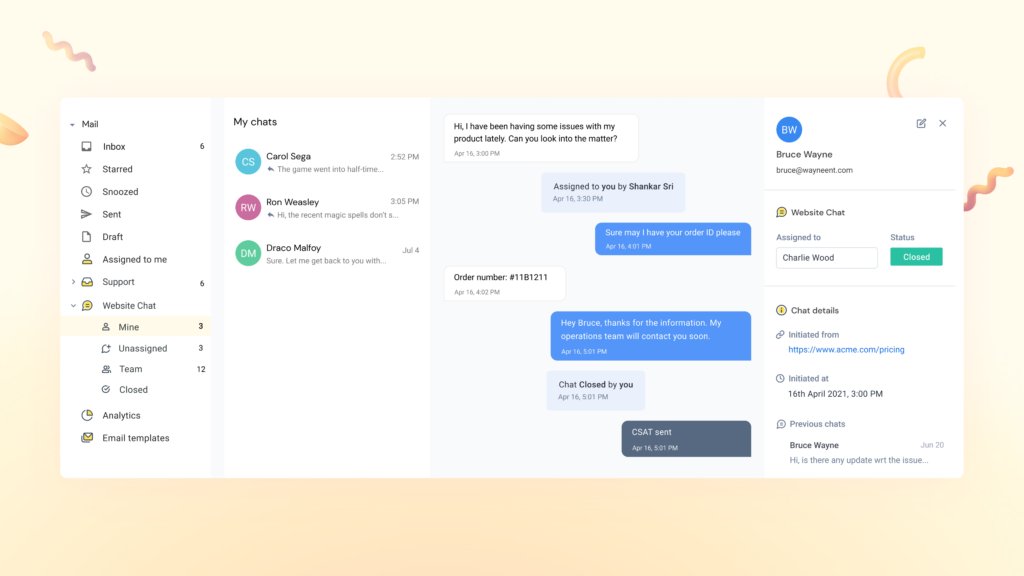
Quick Onboarding: A software that has a short learning curve, enables your team to get up to speed quickly.
Customizability: The ability to customize the interface, automated responses, and other settings can make the software more adaptable to your specific needs.
In-App Guidance: Tooltips, walkthroughs, and a robust help section can assist agents and administrators in using the software effectively.
2. Real-Time Messaging
The core function of live chat is to facilitate real-time conversations between your agents and customers.
Real-time messaging can drastically cut down on customer wait times, leading to increased satisfaction and potentially higher conversion rates.
Look for software that supports typing indicators and read receipts for a more interactive and transparent conversation.
3. Customization
The live chat platform should have the ability to tailor the chat window’s look and feel to match your brand’s aesthetic.
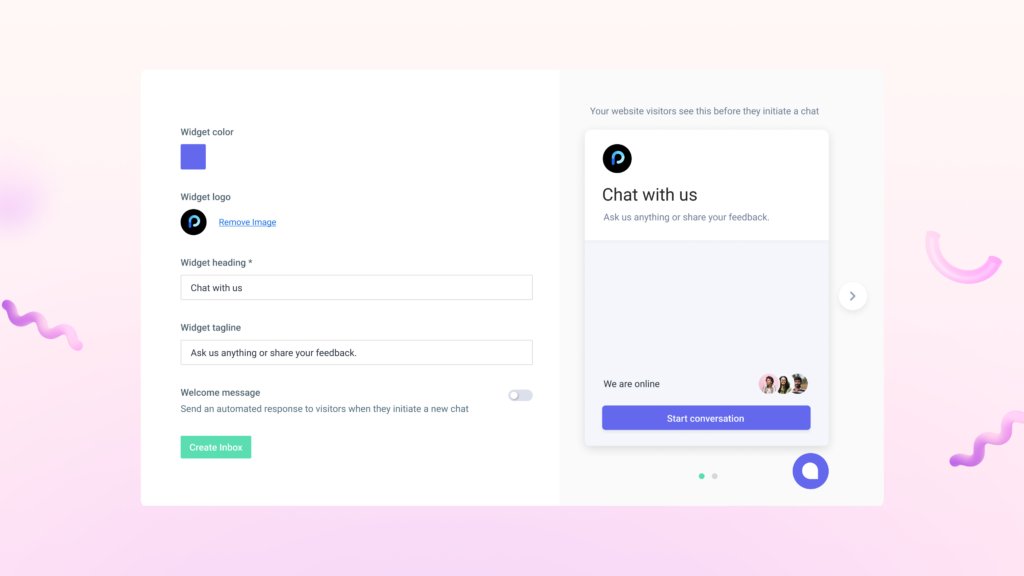
Customization enhances brand consistency and can make customers feel more comfortable and engaged.
Some software allows you to customize not just the appearance but also the greeting messages and prompts, offering a fully branded experience.
4. Automated Responses and Canned Messages
Pre-written responses for common questions or scenarios can speed up response times and free your agents to focus on more complex issues.
Look for software that allows you to easily update and manage your library of canned responses based on evolving customer needs.
5. Multi-Channel Support
The integration of live chat with other customer interaction platforms like social media, email, and SMS ensures you can engage with customers wherever they are, improving their experience and expanding your reach.
Make sure the software can aggregate conversations from different channels into a single dashboard for easier management.
6. Analytics and Reporting
Tools that track and analyze customer interactions, agent performance, and other key metrics.
Analytics can provide actionable insights to continually improve your customer service and even your product or service.
Advanced analytics features might include sentiment analysis and customer journey mapping for deeper insights.
7. File Sharing
The ability for both agents and customers to share files like images, PDFs, and other documents within the chat window.
File sharing can expedite issue resolution, especially for complex problems that require visual aids or documentation.
Ensure the software has adequate security measures to protect sensitive information shared via files.
8. Mobile Responsiveness

Optimize the live chat interface for mobile devices.
With the increasing use of smartphones, mobile responsiveness ensures you’re providing a seamless customer experience when interacting with customers in real-time across all devices.
Look for software that offers a dedicated mobile app for agents, allowing them to respond to chats on the go.
9. Security Features
Ensure measures to protect the privacy and data of both your business and your customers.
Strong security features not only protect against data breaches but also build customer trust.
Check if the software complies with industry-specific regulations like HIPAA for healthcare or GDPR for businesses operating in Europe.
By paying attention to these features and considerations, you’ll be better equipped to choose a live chat support software that’s not just good but great for your business.
Recommended Read:
Top 10 Live Chat Software To Watch Out for in 2024
Get Started
Live chat support isn’t just a tool; it’s an investment in your customer relationships. It’s about meeting your customers where they are and offering immediate, personalized support. It’s about leveraging real-time interactions to not only solve problems but also to understand your customers better, build trust, and even drive sales.
Remember, the best live chat support system is one that aligns with your business goals and customer needs. So take your time, do your research, and make an informed decision. Your customers will thank you, and your bottom line will reflect it.













